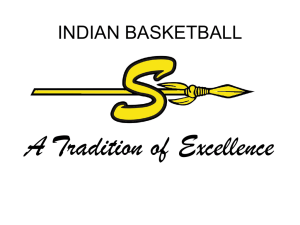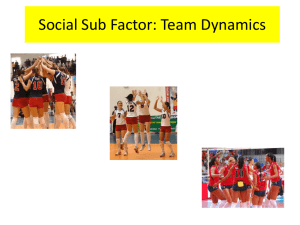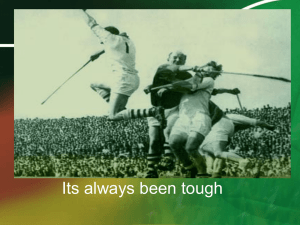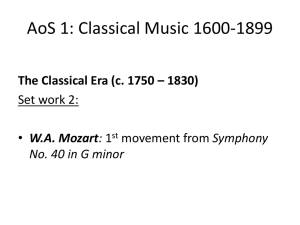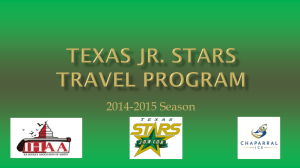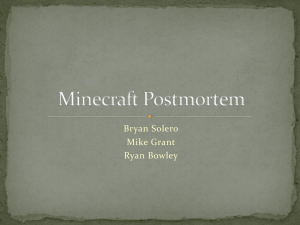Pre-Season Coaches Meeting
advertisement
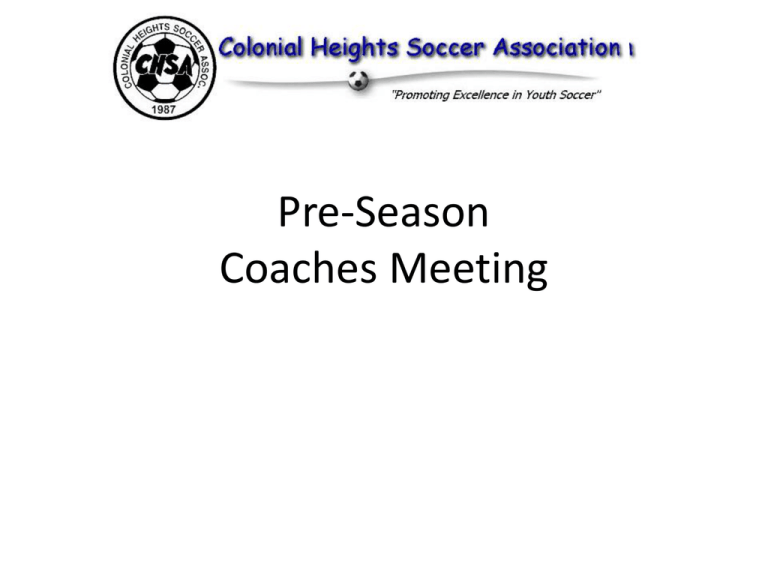
Pre-Season Coaches Meeting It is our goal to ensure that the children of our community are provided with a fun, safe and fair environment in which to learn the game of soccer. We offer the following programs in order to fulfill this objective: U5 Parent/Child Program – This program consists of eight one-hour sessions under the direction of a trained facilitator/trainer. The sessions are held weekly and involve the interaction of both the player and their parent. It is our way of introducing your child and their parent(s) to the game of soccer and our club. There are no formal games as each child is paired with a ball and plays games involving the ball, and sometimes not, in all sessions. Team size for training: 20-30 players per session U6 3v3, Split-Field Format – The U6 child moves to a game that involves two teams on two fields where games of 3 players against 3 players occurs simultaneously. They play four 6 minute quarters and at the end of the second quarter the teams are switched. This allows for all players to play in an ever changing and challenging environment, increasing their chances for success. Team size for training: 8-10 players per team U8 4v4, Split-Field Format – This is an important time in the life of your child for they are just beginning to realize that there is a bigger world out there. This is the same game as the U6 except for the fact that the field increases in size and we add 1 player per side They become aware of other players on the field and are becoming tactically aware of the game. Team size for training: 10-12 players per team U10 6v6, Split-Field Format – This group consists of U9 and U10 players as we begin to increase numbers from 4 a side to 6 a side and allow the use of goalkeepers. The goals and fields are expanded in size but the game remains the same. Team size for training: 15-18 players per team U11 7v7 – The U11 players will begin to play the bigger game. In this age group we introduce the position of keeper and recommend that all players try it. Team size for training: 10 players per team U13 9v9 – This group consists of U12 and U13 players. Two additional players, on each side, are added to the game and the field and goals are again expanded in size to keep the game age appropriate. Team size for training: 15 players per team U16 11v11 – The big game! Full USSF rules! Team size for training: 18 players per team “TRUTHS ABOUT CHILDREN AND SPORTS” Ewing, M. E. & Seefeldt, V. (1990) This study underlines a number of truths about children and sports that have been identified in other research. • Fun is pivotal; if it is not fun, young people won’t play a sport. • Skill development is a crucial aspect of fun; it is more important than winning even among the best athletes. • The most rewarding challenges of sports are those that lead to self-knowledge. • Intrinsic rewards (self knowledge that grows out of self-competition) are more important in creating life-time athletes than are extrinsic rewards (victory or attention from others). More than half of North American Children have their first experience in youth sport before age 9. Participation rates decline sharply, as much as 75%, by the time the children become teenagers. In order for players to remain in the game: • They must possess the basic skills to keep the game fun • They must receive better training in the younger age groups • A creative environment where the freedom to experiment must be allowed and rewarded in training sessions & games • Parental pressures should be minimal • Training sessions need to be interactive and move at a pace to prevent boredom Do You Know That... 1. No one is destined to be unskilled. 2. Understanding the key to the mechanics of sport and play can greatly increase success; at the same time it can reduce the time normally required to improve skills. 3. All individuals can improve their balance. By increasing balance, agility, power and accuracy will improve. Coaching Players U8 and Below Organize practice sessions in advance • Pick a technical subject • Introduce the skill or technique • U6/U7 - Work as individuals with each player having a ball • U8 – Begin to work in pairs, then increase numbers while allowing time for experimentation • Use activities throughout the practice that are fun, reinforce the technical things they have learned. Finish with a game • Tactical training , except in its simplest form (i.e. direction of play), is unnecessary. Through guided discovery, the players will begin to experiment with these decisions, enhancing their learning and understanding of the game from within. Coaching Players U10 and Below Time with the ball! • Training session need to be interactive and move at a pace to prevent boredom • The environment must be fun, fair and safe • Numbers of touches on the ball is paramount • At this age technique must be repeated time and time again • Do not allow bad technique, but remember that it is the technique that is incorrect, separate that from the player • Tactical training , except in its simplest form (i.e. direction of play, width and depth), is unnecessary. Through guided discovery, the players will begin to experiment with these tactical decisions, enhancing their learning and understanding of the game from within. Advanced Tactical training with the best players should not take place until they are 14 or 15 years old. Coaching Players U16 and Below Physical: Does it involve speed, balance flexibility? Technical: Does it stretch their comfort on the ball? Tactical: Does it involve decision making? Psychological: Keep score, become competitive, find a General Training Considerations way to win! Am I able to involve as many players as possible? Do players understand what I am saying? Questions to Consider How much information can they process? How do comments effect players differently? How will my behavior impact the players? Training Session Organization • Developmentally Appropriate • Clear, concise and correct information: Brevity - Clarity - Relevance • Simple to Complex: There should be a flow that is appropriate to the age of the players and the topic of the practice - in some instances this will proceed from a Warm-Up to Individual Activities to Small Group Activities to Large Group Activities (The Game) - While the progression may vary, every practice should start with a warm-up and end with “the game” • Safe and appropriate training area. • Decision making • Are the activities fun? • Implication for the game • Are the activities organized? Activity Training Checklist • Are the players involved in activities? • Is creativity and decision-making being used? • Are spaces being used appropriate? • Is the coaches feedback appropriate? • Are there implications for the game? Pre-season Parent – Coach Meeting • Discuss your coaching philosophy • Discuss team goals • Discuss what is expected of parents; i.e., transportation, communication, general program support, good sportsmanship • Ask for information; i.e., medical history, parent skills inventory • Consider Coach-Player meetings on both an individual and group basis as appropriate • Shin guards Remind Players that they need • Proper shoes • Clothing appropriate for training and climate • Water bottles • To care for equipment and never to hang or climb on a soccer goal! Game Day ROOTS (Rules, Opponents, Officials, Teammates, Self) RESPECT Rules We refuse to bend/break the rules to win. RESPECT Opponents We value and recognize that a worthy opponent brings out our best, and we take a "fierce and friendly" attitude into competition. RESPECT Officials We respect officials even when we disagree with them. RESPECT Teammates We never do anything to embarrass our team (on or off the field). RESPECT Self We live up to our standards of Honoring the Game, even when others don't. Thanks to the following sources: US Youth Soccer’s National Youth License www.usyouthsoccer.org Virginia Youth Soccer Assoc Coaching Education www.vysa.com Liberty Mutual Insurance www.responsiblesports.com


